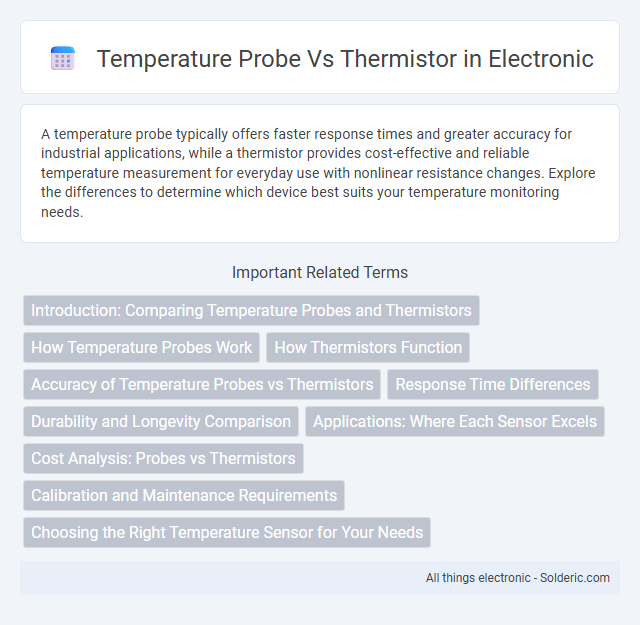A temperature probe typically offers faster response times and greater accuracy for industrial applications, while a thermistor provides cost-effective and reliable temperature measurement for everyday use with nonlinear resistance changes. Explore the differences to determine which device best suits your temperature monitoring needs.
Comparison Table
| Feature | Temperature Probe | Thermistor |
|---|---|---|
| Measurement Principle | Electrical resistance changes with temperature or thermoelectric effect (RTD or thermocouple types) | Resistance changes non-linearly with temperature (Negative or Positive Temperature Coefficient) |
| Temperature Range | -200degC to +1800degC (depending on type) | -50degC to +150degC (typical range) |
| Accuracy | High accuracy (+-0.1degC to +-1degC) | Moderate accuracy (+-0.1degC to +-2degC) |
| Response Time | Fast to moderate, depends on probe design | Very fast response time |
| Durability | Robust, suitable for harsh environments | Less durable, sensitive to mechanical stress |
| Cost | Moderate to high depending on type and accuracy | Low cost and widely available |
| Applications | Industrial, scientific measurements, HVAC, food processing | Medical devices, consumer electronics, automotive sensors |
Introduction: Comparing Temperature Probes and Thermistors
Temperature probes and thermistors both measure temperature but differ in technology and applications. Temperature probes often use thermocouples or resistance temperature detectors (RTDs) providing broad temperature ranges and high accuracy. Thermistors rely on semiconductor materials with resistance that changes significantly with temperature, ideal for precise, low-range measurements.
How Temperature Probes Work
Temperature probes work by sensing heat through materials with temperature-dependent properties, such as metals or semiconductors, converting thermal energy into electrical signals. Thermistors, a common type of temperature probe, utilize semiconductor materials whose resistance changes predictably with temperature variations, allowing precise measurement. Your choice between a temperature probe or thermistor depends on the required accuracy, response time, and environmental conditions.
How Thermistors Function
Thermistors function by changing their electrical resistance in response to temperature variations, allowing precise measurement of temperature changes through resistance readings. Unlike temperature probes that may employ different sensing technologies such as thermocouples, thermistors rely on semiconductor materials whose resistance decreases as temperature increases (NTC) or increases with temperature (PTC). Understanding these characteristics helps you select the optimal sensor for accurate thermal monitoring in applications like HVAC systems, medical devices, and industrial processes.
Accuracy of Temperature Probes vs Thermistors
Temperature probes generally offer higher accuracy and faster response times compared to thermistors, making them ideal for precision-critical applications. Thermistors, while cost-effective and sensitive, can exhibit nonlinear behavior and are less stable over a wide temperature range. Your choice depends on the required measurement accuracy, with probes preferred for precise and reliable temperature readings.
Response Time Differences
Temperature probes with thermocouples typically exhibit faster response times than thermistors due to their ability to detect rapid temperature changes through metal junctions. Thermistors, composed of semiconductor materials, respond slower as their resistance changes gradually with temperature shifts. For applications requiring quick thermal detection, thermocouples are preferred, while thermistors suit scenarios needing high sensitivity but slower response.
Durability and Longevity Comparison
Temperature probes typically offer greater durability and longevity compared to thermistors due to their robust construction with metal or glass encapsulation. Thermistors, while highly sensitive and accurate for short-term use, are more prone to damage from mechanical stress and thermal cycling, leading to limited lifespan. Industrial applications favor temperature probes for extended use in harsh environments where long-term stability is critical.
Applications: Where Each Sensor Excels
Temperature probes excel in industrial and scientific applications requiring precise, real-time temperature measurements, such as HVAC systems, food safety monitoring, and laboratory experiments. Thermistors are ideal for consumer electronics, medical devices, and home appliances due to their high sensitivity and rapid response to temperature changes. Your choice between these sensors depends on the accuracy, environment, and response time needed for your specific application.
Cost Analysis: Probes vs Thermistors
Temperature probes generally incur higher upfront costs compared to thermistors due to their robust build and enhanced accuracy for industrial applications. Thermistors offer a cost-effective solution for temperature measurement in consumer electronics and HVAC systems, benefiting from lower manufacturing expenses and simpler materials. When evaluating lifecycle costs, temperature probes may provide greater long-term value in precision-critical environments despite their initial price premium.
Calibration and Maintenance Requirements
Temperature probes typically require less frequent calibration than thermistors due to their stable output and robust design, making them suitable for long-term use in industrial environments. Thermistors, with their higher sensitivity and non-linear resistance changes, demand more rigorous and regular calibration to maintain measurement accuracy. Proper maintenance of thermistors includes periodic verification against reference standards, while temperature probes often need only occasional checks to ensure sensor integrity and consistent performance.
Choosing the Right Temperature Sensor for Your Needs
Choosing the right temperature sensor depends on accuracy, range, and application requirements. Temperature probes, often using thermocouples, provide a wide temperature range and fast response, ideal for industrial environments. Thermistors offer higher sensitivity and precision within a narrower temperature range, making them perfect for medical and consumer electronics applications.
temperature probe vs thermistor Infographic

 solderic.com
solderic.com